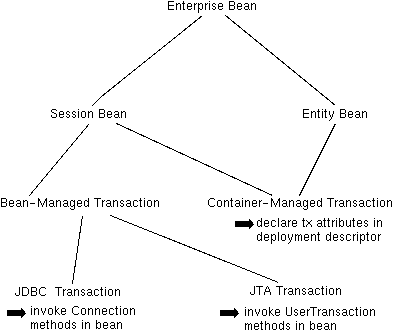
| Prev | Next | J2EETM Developer's Guide
Transactions |
setRollbackOnly method of the EJBContext interface. A session bean may have either container-managed or bean-managed transactions. There are two types of bean-managed transactions: JDBC and JTA transactions. You delimit JDBC transactions with the commit and rollback methods of the Connection interface. To demarcate JTA transactions, you invoke the begin, commit, and rollback methods of the UserTransaction interface.
In a session bean with bean-managed transactions, it is possible to mix JDBC and JTA transactions. This practice is not recommended, however, because it could make your code difficult to debug and maintain.
If you're unsure about how to set up transactions in an enterprise bean, here's a tip: In the deployment descriptor specify container-managed transactions. Then, set the Required transaction attribute for the entire bean. This approach will work most of the time.
FIGURE 6-2 Options in Specifying Transactions